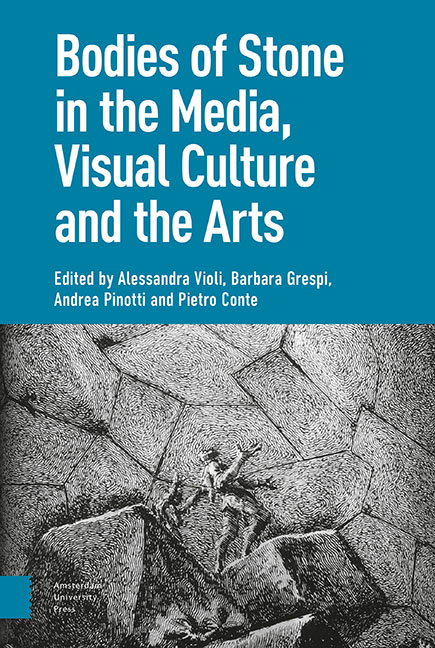Book contents
- Frontmatter
- Contents
- Introduction: Learning from Stone
- I Statue: The Imaginary of Uncertain Petrification
- 1 Theatre and Memory: The Body-as-Statue in Early Modern Culture
- 2 Translated Bodies: A ‘Cartographic’ Approach
- 3 Pantomime in Stone: Performance of the Pose and Animal Camouflage
- 4 Animated Statues and Petrified Bodies: A Journey Inside Fantasy Cinema
- 5 The Ephemeral Cathedral: Bodies of Stone and Configurations of Film
- II Matter: Size, Hardness, Duration
- 1 Bodies That Matter: Miniaturisation and the Origin(s) of ‘Art’
- 2 Brancusi’s ‘Sculpture for the Blind’
- 3 Cinema, Phenomenology and Hyperrealism
- 4 Ephemeral Bodies: The ‘Candles’ of Urs Fischer
- 5 The Celluloid and the Death Mask: Bazin’s and Eisenstein’s Image Anthropology
- III Corpse: Fossils, Auto-Icons, Revenants
- 1 Funeral Eulogy: Post-Mortem Figures and Redeemed Bodies, in Images
- 2 On Jack Torrance As a Fossil Form
- 3 Technical Images and the Transformation of Matter in Eighteenth-Century Tuscany
- 4 Glass, Mixed Media, Stone: The Bodily Stuffs of Suspended Animation
- 5 Bodies’ Strange Stories: Les Revenants and The Leftovers
- IV Monument: Embodying and Grafting
- 1 The Impassibly Fleshly, the Statue of the Impossible
- 2 Frozen into Allegory: Cleopatra’s Cultural Survival
- 3 The Orphan Image
- 4 The Well-Tempered Memorial: Abstraction, Anthropomorphism, Embodiment
- 5 Monuments of the Heart: Living Tombs and Organic Memories in Contemporary Culture
- Index
1 - Funeral Eulogy: Post-Mortem Figures and Redeemed Bodies, in Images
Published online by Cambridge University Press: 20 November 2020
- Frontmatter
- Contents
- Introduction: Learning from Stone
- I Statue: The Imaginary of Uncertain Petrification
- 1 Theatre and Memory: The Body-as-Statue in Early Modern Culture
- 2 Translated Bodies: A ‘Cartographic’ Approach
- 3 Pantomime in Stone: Performance of the Pose and Animal Camouflage
- 4 Animated Statues and Petrified Bodies: A Journey Inside Fantasy Cinema
- 5 The Ephemeral Cathedral: Bodies of Stone and Configurations of Film
- II Matter: Size, Hardness, Duration
- 1 Bodies That Matter: Miniaturisation and the Origin(s) of ‘Art’
- 2 Brancusi’s ‘Sculpture for the Blind’
- 3 Cinema, Phenomenology and Hyperrealism
- 4 Ephemeral Bodies: The ‘Candles’ of Urs Fischer
- 5 The Celluloid and the Death Mask: Bazin’s and Eisenstein’s Image Anthropology
- III Corpse: Fossils, Auto-Icons, Revenants
- 1 Funeral Eulogy: Post-Mortem Figures and Redeemed Bodies, in Images
- 2 On Jack Torrance As a Fossil Form
- 3 Technical Images and the Transformation of Matter in Eighteenth-Century Tuscany
- 4 Glass, Mixed Media, Stone: The Bodily Stuffs of Suspended Animation
- 5 Bodies’ Strange Stories: Les Revenants and The Leftovers
- IV Monument: Embodying and Grafting
- 1 The Impassibly Fleshly, the Statue of the Impossible
- 2 Frozen into Allegory: Cleopatra’s Cultural Survival
- 3 The Orphan Image
- 4 The Well-Tempered Memorial: Abstraction, Anthropomorphism, Embodiment
- 5 Monuments of the Heart: Living Tombs and Organic Memories in Contemporary Culture
- Index
Summary
Abstract
The essay explores the relationship between dead bodies, statues and photographs, individuating in the images not only a means for petrifying bodies, embalming them in time—as argued by Barthes, Debray and Dubois—but also a form of re-animation of the inanimate. A sort of living relic, the image is the frozen testimony of a fleeting vitality, a paradoxical form of ‘visible hiding’ in which life and death are intertwined. The essay demonstrates this process in some contemporary works, moving from The Hidden Mother(L. Fregni Nagler, 2013), a series of portraits of babies from the late nineteenth century. In these bodies of babies still alive, but in which livestheir very same corpse, death is a phantom but also a tangible fear behind the photographic gesture.
Keywords: Photograph; statues; body; re-animation; The Hidden Mother
The analogy between the dead body and the inanimate body of the statue is rather abused, based as it is on some qualifying traits they quite obviously share: stiffness; stillness; a single, unchangeable expression. Indeed, the very idea that the statue is ‘a dead body which stands firmly erect, greeting pedestrians from a distance’ is perfectly consistent with the broader analogy between images and death. This analogy, as Hans Belting has pointed out, is ‘as old as the figurative power itself’. The function of the image as a livingsubstitute for the dead body—that is, ‘not as a stony metaphor of the person who passed away, but as a real metonymy, an exalted yet physical extension of its own flesh’—goes back to the idea that ‘figuring and transfiguring are […] one and the same thing’. This connection between images and death is still considered both by visual anthropologists and by scholars of visual culture as one of the main presuppositions of art-making. Therefore, it is regarded not only as the historical origin of images but also as the gesture behind their invention (in its different forms) which seems to fill a gap, literally re-presenting an absence and filling a void, particularly the void left by death.
- Type
- Chapter
- Information
- Bodies of Stone in the Media, Visual Culture and the Arts , pp. 211 - 230Publisher: Amsterdam University PressPrint publication year: 2020

